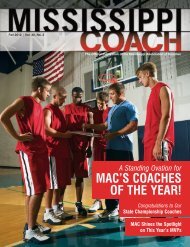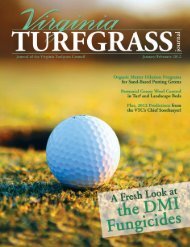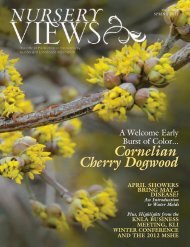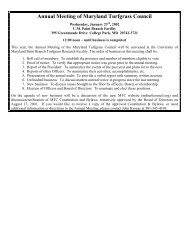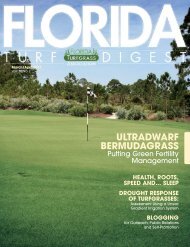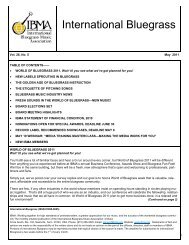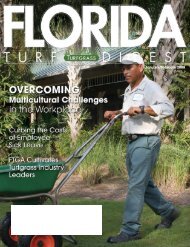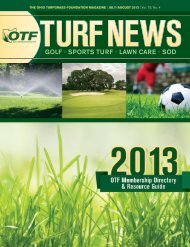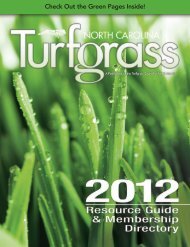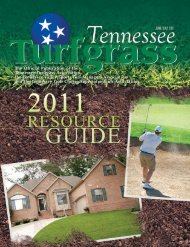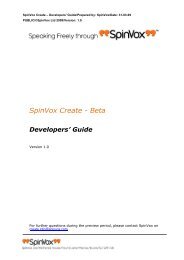Killer Turf Diseases ConTrol sTraTeGies - The Paginator
Killer Turf Diseases ConTrol sTraTeGies - The Paginator
Killer Turf Diseases ConTrol sTraTeGies - The Paginator
Create successful ePaper yourself
Turn your PDF publications into a flip-book with our unique Google optimized e-Paper software.
<strong>The</strong> Ohio <strong>Turf</strong>grass Foundation Magazine | May/June 2013 | Vol. 75, No. 3<br />
<strong>Killer</strong><br />
<strong>Turf</strong><br />
<strong>Diseases</strong><br />
…Summer Patch and<br />
Gray Leaf Spot<br />
Control<br />
Strategies<br />
for Summer Annual<br />
Broadleaf Weeds
<strong>The</strong> Ohio <strong>Turf</strong>grass Foundation Magazine • <strong>Turf</strong> NEWS<br />
3
Contents<br />
<strong>The</strong> Ohio <strong>Turf</strong>grass Foundation Magazine<br />
May/June 2013 | Vol. 75, No. 3<br />
<strong>The</strong> Ohio <strong>Turf</strong>grass Foundation<br />
1550 Old Henderson Rd., Ste. N-164<br />
Columbus, OH 43220<br />
Voice/Text: (614) 285-4683<br />
info@ohioturf.org | www.Ohio<strong>Turf</strong>grass.org<br />
Features<br />
6 OTF MEMBER<br />
Spotlight<br />
Meet Jim Walter,<br />
LawnAlive, LCC<br />
10 TURF TALK<br />
<strong>Killer</strong> <strong>Turf</strong> <strong>Diseases</strong>…<br />
Summer Patch and<br />
Gray Leaf Spot<br />
14 TURF TIPS<br />
Control Strategies<br />
for Summer Annual<br />
Broadleaf Weeds<br />
Departments<br />
6 President’s Message<br />
8 News from OSU<br />
17 Calendar of Events<br />
18 Index of Advertisers<br />
18 OSU <strong>Turf</strong> Science Team<br />
<strong>Turf</strong> News distributes useful and timely advice,<br />
information and research from Ohio’s most knowledgeable<br />
experts and professionals to OTF members<br />
and those in the turfgrass industry.<br />
Publisher<br />
Leading Edge Communications, LLC<br />
206 Bridge St. | Franklin, TN 37064<br />
Phone: (615) 790-3718 | Fax: (615) 794-4524<br />
info@leadingedgecommunications.com<br />
OTF Officers<br />
President<br />
Mike Dietrich<br />
John Deere Landscapes<br />
Nokomis, FL<br />
Vice President<br />
Don Lawrence<br />
Blanchard Valley <strong>Turf</strong><br />
& Ornamental<br />
Findlay, OH<br />
Treasurer<br />
Ryan Gregoire<br />
Agricultural Design, Inc.<br />
Westfield Center, OH<br />
Past President<br />
Kim Kellogg<br />
Grasshopper Prop. Maint.<br />
Millersburg, OH<br />
Trustees<br />
Jim Dillard<br />
<strong>The</strong> Hill Company /<br />
Professional Growth Products<br />
Gahanna, OH<br />
Kyle Frederick<br />
Rattlesnake Ridge G.C.<br />
Sunbury, OH<br />
Tim Glorioso<br />
Toledo Country Club<br />
Toledo, OH<br />
Andrew Muntz<br />
Trupointe Cooperative, Inc.<br />
Columbus, OH<br />
Jason Straka<br />
Fry Straka Global Golf Course Design<br />
Columbus, OH<br />
Randy Tischer<br />
Green Velvet Sod Farms<br />
Bellbrook, OH<br />
Gina Zirkle<br />
Scotts Miracle-Gro<br />
Marysville, OH<br />
Director of Education<br />
John Street, Ph.D.<br />
<strong>The</strong> Ohio State University<br />
Columbus, OH | (614) 292-9091<br />
street.1@osu.edu<br />
Executive Director<br />
Brian Laurent<br />
Office: (614) 285-4683<br />
Cell: (614) 989-2445<br />
brian@ohioturf.org<br />
4 <strong>Turf</strong> NEWS • May/June 2013
President’s Message<br />
OTF Member<br />
Spotlight<br />
Giving<br />
You<br />
More<br />
for Your Membership Dollar<br />
Mike Dietrich<br />
2013 OTF President<br />
Value is defined as relative worth, merit or importance. It’s what organizations<br />
such as ours strive to provide to members, event participants and exhibitors.<br />
Your board of trustees and executive director have been working to provide<br />
you with more value for your investment in the Foundation.<br />
For starters, we’re working to enhance the interaction between our members. <strong>The</strong> new<br />
OTF website gives members an opportunity to maintain personal profile pages, blogs and<br />
more. It will provide you with an opportunity to participate in industry-specific forums<br />
to interact with your peers and trade ideas. As the season and its challenges continue to<br />
evolve, we hope that you will utilize this resource to learn from one another and expand<br />
your professional network.<br />
<strong>The</strong> OTF <strong>Turf</strong>grass Research Field Day Committee recently recommended slight<br />
changes to give you more value for attending the event. This year’s Field Day (August 7)<br />
will feature fewer stops but more time at most stations. This will help researchers present<br />
more in-depth “take-home” information and will allow us to offer more ODA recertification<br />
credits. This year, we will also incorporate equipment and other product demonstrations.<br />
This will allow you to see, ask questions about and test (or see results) some of the<br />
latest products. For our industry partners, this gives you an opportunity to show off your<br />
products to hundreds of turfgrass managers in one day!<br />
Our Legislative Committee has done a tremendous job of staying involved and active<br />
in conversations pertaining to industry issues. For the second year in a row, we participated<br />
in <strong>Turf</strong>grass Day at the Capitol in conjunction with other industry groups. Thanks to Gina<br />
Zirkle, Belinda Jones and Kristina McCann for their work in arranging this event during<br />
our Ohio <strong>Turf</strong>grass Week celebration. <strong>The</strong> event continues to provide us with exposure at<br />
the Capitol to discuss legislation and to promote the benefits of turf and the importance<br />
of our industry.<br />
Finally, we’re continuing our work with the Ohio State <strong>Turf</strong> Team to provide you with<br />
regular updates via Weekly Clippings and <strong>Turf</strong> Tips emails. We hope that you find the<br />
information in these pieces useful in managing your facilities and businesses. <strong>The</strong> <strong>Turf</strong><br />
Team at Ohio State is one of the most respected in the industry and one with which we<br />
are proud to be partners. If you’re not utilizing the Extension services available to you, I<br />
highly recommend that you consider doing so.<br />
If there are ways that we can enhance the value of your investment with OTF and the<br />
industry, please let us know. We are always looking for ways to improve! Thanks for your<br />
continued support of this Foundation and the turfgrass industry.<br />
Mike Dietrich<br />
2013 OTF President<br />
Meet Jim<br />
Walter,<br />
LawnAlive, LLC<br />
Jim’s job position with LawnAlive:<br />
Founder/Owner/Operator<br />
His educational background:<br />
<strong>The</strong> Ohio State University, BS in Horticulture/Business<br />
Administration; Baldwin-<br />
Wallace College, MBA<br />
Business location:<br />
Elyria, OH<br />
Favorite part of his job:<br />
“Managing my own business and watching<br />
it grow beautiful lawns.”<br />
OTF Member since 1981:<br />
“Being an OTF Member is important<br />
because it brings wisdom, power and professionalism<br />
to my business.”<br />
His best turf-related experiences:<br />
“One of my best OTF experiences was visiting<br />
the underground laboratory many years<br />
ago at OSU. It gave me great confidence and<br />
authority when speaking to a world concerned<br />
with ground water contamination. Also, getting<br />
to play golf on the legendary Inverness<br />
golf course years ago.” m<br />
6 <strong>Turf</strong> NEWS • May/June 2013
News from OSU<br />
Donations<br />
of Equipment and Products<br />
Are Critical to the Operation of the Research Facility<br />
By Matt Williams, Program Coordinator, <strong>The</strong> Ohio State University<br />
As<br />
the growing season kicks<br />
into full gear, research<br />
trials are popping up all<br />
over at the OSU/OTF<br />
<strong>Turf</strong>grass Research and Education Facility.<br />
<strong>The</strong> operation of the facility is a unique partnership<br />
between OSU, industry groups, turfgrass-oriented<br />
companies and turfgrass professionals.<br />
All of these groups contribute to<br />
the research center, and it couldn’t function<br />
without them.<br />
One of the most significant contributions<br />
comes from the Ohio <strong>Turf</strong>grass Foundation.<br />
As a matter of fact, it is because of OTF that<br />
we have the facility from which we operate.<br />
In the late 1980s, it was clear that the OSU<br />
turfgrass research program was growing to the<br />
point that a new facility needed to be built.<br />
During these years, the OTF board of directors<br />
developed a plan to build a state-of-theart<br />
research facility and donate it to the University.<br />
Construction began in 1995, and the<br />
new building opened in 1996.<br />
Ever since then, OTF has provided the<br />
OSU turfgrass program with the annual operating<br />
budget for the research facility. This<br />
year’s budget is $60,000; this covers the dayto-day<br />
operations and long-term goals of the<br />
research center. <strong>The</strong>se funds are used to pay<br />
student workers, purchase and service equipment,<br />
repair and maintain the irrigation system,<br />
purchase fuel and oil and take care of<br />
the building and grounds. This operating<br />
budget doesn’t include funds for large<br />
mowing equipment or many turf-maintenance<br />
products.<br />
<strong>The</strong> research center uses over 25 pieces<br />
of equipment to maintain the grounds and<br />
research areas. Most of this equipment has<br />
been donated or is on a seasonal loan. Typically,<br />
manufacturers will allow local dealers<br />
and distributors to loan equipment to the<br />
research center for a period of six months to<br />
one year. This season, we have equipment<br />
loaned to us from <strong>The</strong> Toro Company/<br />
Century Equipment, Jacobsen/Baker Vehi-<br />
8 <strong>Turf</strong> NEWS • May/June 2013
cle and Exmark/Buckeye Power Sales, as well<br />
as Bernhard and Company/Reynolds Golf<br />
and <strong>Turf</strong>. All the daily mowing and maintenance<br />
is done with these donated machines.<br />
<strong>The</strong>se equipment loans are beneficial to<br />
both parties. <strong>The</strong> research center benefits by<br />
having the appropriate equipment to conduct<br />
the various research trials, which we would<br />
otherwise not have funding to purchase or<br />
lease. In addition, we are able to expose the<br />
15+ student workers at the facility to these<br />
products and train them on the latest in turfmaintenance<br />
technology. Also, our students<br />
in the turfgrass science program get to see<br />
and use this equipment during labs held at<br />
the farm. Moreover, having new equipment<br />
under warranty reduces maintenance costs.<br />
<strong>The</strong> equipment manufacturers and dealers<br />
benefit by having their equipment and<br />
brands exposed to the countless industry<br />
personnel that visit the facility every season.<br />
<strong>The</strong>y also benefit by exposing their equipment<br />
to the student workers, student classes,<br />
industry tours and educational events at the<br />
facility. After all, these are the people who<br />
will be making purchasing decisions in the<br />
near future. <strong>The</strong> companies that loan equipment<br />
to the research center also appreciate<br />
feedback on their equipment. Often, we are<br />
loaned their latest equipment or prototypes<br />
and asked for input on ways to improve the<br />
machines before they are sent to the market.<br />
OTF members can also benefit from<br />
these equipment loans. At the end of the loan<br />
period, the local dealers are able to sell these<br />
units with very low hours at a reduced cost.<br />
Another essential support category is<br />
soft goods. This faction includes fertilizers,<br />
pesticide, seed, topdressing and sod. Most<br />
of the products that we use at the turf center<br />
have been donated by manufacturers and<br />
retailers. <strong>The</strong>se companies find similar benefits<br />
as the companies that donate equipment.<br />
This year alone, we have received products<br />
and donations from <strong>The</strong> Andersons,<br />
Milorganite, Trupointe, Syngenta, FMC,<br />
BASF, Advance <strong>Turf</strong> Solutions, <strong>The</strong> Olen<br />
Corporation, Quali-Pro and Agrium.<br />
Although the university provides<br />
some support for building maintenance and<br />
repairs, the turfgrass research facility would<br />
not be possible without the generous support<br />
of the Ohio turfgrass industry. If you<br />
or your company is interested in donating<br />
products, services or supplies to the OTF/<br />
OSU <strong>Turf</strong>grass Research Facility, please<br />
contact Matt Williams at 614-292-6264 or<br />
williams.1278@osu.edu. m<br />
<strong>The</strong> Ohio <strong>Turf</strong>grass Foundation Magazine • <strong>Turf</strong> NEWS<br />
9
<strong>Turf</strong> Talk<br />
A single “patch” in a Kentucky bluegrass lawn; often, there<br />
is green turf in the middle of the infected patch.<br />
A lawn with extensive damage from patch disease. Note that<br />
there can be variable shapes and patterns of damaged turf.<br />
<strong>The</strong> plant crowns are often killed.<br />
10 <strong>Turf</strong> NEWS • May/June 2013
By Joseph W. Rimelspach, Francesca Peduto Hand, Ph.D., and Todd E. Hicks,<br />
Dept. of Plant Pathology, <strong>The</strong> Ohio State University<br />
<strong>The</strong><br />
majority of<br />
turfgrass diseases<br />
in Ohio cause<br />
injury to plant<br />
leaves but are not a life-threatening problem.<br />
However, the following two diseases — summer<br />
patch and gray leaf spot — usually kill<br />
the infected plants and result in extensive<br />
renovation of the killed lawn, athletic field or<br />
golf fairway/roughs. Early detection or knowing<br />
if there is a history of these diseases<br />
is extremely important for successful management,<br />
as well as for setting proper customer<br />
expectations.<br />
<strong>The</strong> good news is that summer patch and<br />
gray leaf spot are not widespread, but when<br />
they are present in the turf, serious damage<br />
can result. Both diseases were reported and<br />
confirmed in Ohio last year, and both develop<br />
under their own set of summer stress environmental<br />
conditions. Be alert, and be knowledgeable<br />
on what to look for to accurately<br />
diagnose these, and be prepared to avoid<br />
problems and manage the diseases.<br />
Summer patch<br />
Diagnostic information<br />
Symptoms of summer patch, caused by<br />
Magnaporthe poae, are most prevalent and<br />
severe during hot, humid or wet weather on<br />
stressed turfgrass grown in poor, compacted<br />
soils. Soil pH does not appear to influence<br />
summer patch the way it does takeall<br />
patch.<br />
Disease colonization of the turf plant<br />
(roots, crowns and stems) begins when soil<br />
temperatures reach 65°F to 70°F, but symptoms<br />
generally don’t appear until later in the<br />
season when temperatures peak (85°F to<br />
95°F). Since the roots and stems are infected,<br />
the translocation of water is hindered and<br />
reduced, so the plants wilt and turn brown<br />
due to insufficient water.<br />
In turfgrass stands, the disease shows up as<br />
irregular patches, rings and crescents. Individual<br />
patches are typically about 12" in<br />
diameter, but they often coalesce. <strong>The</strong> roots,<br />
crowns and stems of heavily infected turf-<br />
grass are often severely darkened due to the<br />
presence of a large amount of ectotrophic<br />
runner hyphae (the fungus). This is a key<br />
diagnostic sign.<br />
Management and<br />
control strategy<br />
<strong>The</strong> first line of defense to preventing or minimizing<br />
summer patch is through the selection<br />
and/or use of disease-resistant turfgrass<br />
species/cultivars. Unfortunately, the use of<br />
genetically resistant turfgrass is limited to<br />
newly established or renovated turfgrass areas<br />
or in situations where overseeding is used.<br />
Many of the newly released Kentucky bluegrass<br />
varieties offer resistance to summer<br />
patch. Information regarding disease resistance<br />
can be obtained by contacting local turfgrass<br />
seed distributors, Extension specialists<br />
and the National <strong>Turf</strong>grass Evaluation Program<br />
at http://www.ntep.org.<br />
Practical management of summer patch<br />
begins with the use of cultural practices<br />
designed to reduce stress and optimize<br />
A perennial ryegrass fairway with large sections killed by<br />
gray leaf spot.<br />
Predominately perennial ryegrass, this soccer field was killed by<br />
gray leaf spot. <strong>The</strong> only alive/green grass in the field were other<br />
species of cool-season grasses or bermudagrass.<br />
<strong>The</strong> Ohio <strong>Turf</strong>grass Foundation Magazine • <strong>Turf</strong> NEWS<br />
11
<strong>Turf</strong> Talk<br />
turfgrass health. Management practices that<br />
promote adequate drainage, reduce soil compaction<br />
and promote healthy root growth,<br />
along with an appropriate fertility program,<br />
are important to avoiding summer patch.<br />
Avoid the use of quick-release N fertilizers<br />
— the slower the nitrogen release, the<br />
better. For summer applications, use at least<br />
75% slow-release N materials.<br />
Also, use frequent irrigation to avoid<br />
moisture stress. Often, mid-day watering is<br />
recommended to avoid wilt, cool the plants<br />
and compensate for a weak root system. It is<br />
much like managing new sod without an<br />
established root system. Remember that the<br />
roots are infected and not functioning well,<br />
so compensate through careful management<br />
of fertility programs and irrigation.<br />
Manage the turf to maintain minimal<br />
thatch and to reduce soil compaction. Very<br />
heavy core cultivation is recommended at<br />
least twice a year.<br />
Fungicide management is difficult since<br />
the products must be placed in the crown and<br />
root system area to be affective. Applications<br />
also need to start early before the roots are<br />
infected (when soil temperatures at 2" reach<br />
65°F to 70°F for several days). For specific<br />
fungicides, refer to the OSU <strong>Turf</strong>grass Pathology<br />
Program website at http://turfdisease.<br />
osu.edu. Look under Publications for the<br />
“Management of <strong>Turf</strong>grass <strong>Diseases</strong>” bulletin<br />
(L-187 Disease Section). Always read the fungicide<br />
label, and follow all instructions.<br />
Gray leaf spot<br />
Diagnostic information<br />
Caused by the fungus Piriculia grisea, gray<br />
leaf spot is a devastating disease of perennial<br />
ryegrass turfgrass (Kentucky bluegrass, fine<br />
fescues, bentgrass and many perennial weedy<br />
grasses are not affected). Severe outbreaks<br />
look as if the turf has been scorched with<br />
a flamethrower!<br />
Initially, symptoms may appear similar<br />
to those of drought. <strong>The</strong> pathogen kills the<br />
plant by causing severe leaf blight. Part of the<br />
blighting process involves the production of<br />
phytotoxic chemicals that disrupt the normal<br />
biochemical and physiological balance within<br />
the turfgrass. Initial symptoms often appear<br />
as small pinprick lesions that may go unnoticed<br />
or mistaken as a less aggressive leaf spot<br />
disease. Under optimal environmental and<br />
host conditions, these small spots quickly turn<br />
into water-soaked spots, which then coalesce<br />
into water-soaked leaf tips, which then progress<br />
rapidly to twisted, necrotic leaf tips.<br />
In later stages of disease development, the<br />
sward may take on a gray color as a result of<br />
the mass production of conidia (spores) by<br />
the pathogen (hence its name, gray leaf spot).<br />
In most cases, the ryegrass will quickly die<br />
and appears as drought stress; however, the<br />
soil is wet, with plenty of moisture, and the<br />
relative humidity is high. In years when the<br />
disease is the most widespread in Ohio, there<br />
is a strong correlation to weather patterns of<br />
warm days and nights and high humidity and<br />
rainfall from the remains of hurricanes that<br />
trace through the state.<br />
12 <strong>Turf</strong> NEWS • May/June 2013
During long periods of above-normal temperatures<br />
in summer and fall, gray leaf spot<br />
develops throughout the Midwest. Here in<br />
Ohio, the southern two-thirds of the state<br />
are primarily at risk; in 2006, 2007 and 2012,<br />
however, the disease was confirmed in the<br />
Toledo, Cleveland and Akron areas. <strong>The</strong> disease<br />
has been observed especially frequently<br />
on ryegrass athletic fields, golf course fairways<br />
and roughs and home lawns. More samples<br />
of gray leaf spot were confirmed at the OSU<br />
Plant and Pest Diagnostic Clinic in 2005 than<br />
in any other year, due to the ideal weather<br />
conditions that summer and fall.<br />
Management and<br />
control strategies<br />
• Reduce, limit or avoid nitrogen fertilizer in<br />
the summer. Avoid quick-release sources<br />
of nitrogen.<br />
• Irrigate in early morning, and avoid evening<br />
irrigation. Check the soil moisture<br />
level because the disease mimics drought<br />
stress. Over-watering caused by misdiagnosis<br />
increases the severity of this disease.<br />
• On athletic fields, be wary of using rain<br />
tarps during gray leaf spot-susceptible times.<br />
• Seed with a resistant type of turfgrass, such<br />
as Kentucky bluegrass or one of the fescues.<br />
Remember that seedling perennial ryegrasses<br />
are extremely susceptible to infection<br />
of gray leaf spot and can easily be<br />
killed if the disease is active.<br />
• New perennial ryegrass cultivars are being<br />
developed that show reduced susceptibility<br />
to the disease. For the latest trial<br />
results of perennial ryegrass, check with the<br />
National <strong>Turf</strong>grass Evaluation Program at<br />
www.ntep.org.<br />
• To prevent damage, chemical management<br />
must be timely or at the earliest indication<br />
of the disease. For specific fungicides, refer<br />
to the OSU <strong>Turf</strong> grass Pathology Program<br />
website http://turfdisease.osu.edu. Look<br />
under Publications for the “Management<br />
of <strong>Turf</strong>grass <strong>Diseases</strong>” bulletin (L-187<br />
Disease Section). Always read the fungicide<br />
label, and follow all instructions.<br />
Need help with<br />
diagnosing a problem?<br />
If you need to have a laboratory diagnosis to<br />
identify or confirm a turf problem, submit a<br />
sample to the C. Wayne Ellett Plant & Pest<br />
Diagnostic Clinic at <strong>The</strong> Ohio State University.<br />
Send turf samples to:<br />
201 Kottman Hall<br />
2021 Coffey Road<br />
Columbus, OH 43210<br />
For more information on collecting and<br />
submitting a sample, see the C. Wayne Ellett<br />
Plant & Pest Diagnostic Clinic website at<br />
http://ppdc.osu.edu. m<br />
<strong>The</strong> Ohio <strong>Turf</strong>grass Foundation Magazine • <strong>Turf</strong> NEWS<br />
13
<strong>Turf</strong> Tips<br />
Control Strategies for<br />
Summer Annual Broadleaf Weeds<br />
David Gardner, Ph.D., Dept. of Horticulture and Crop Science, <strong>The</strong> Ohio State University<br />
Although fall is the best time<br />
to control perennial weeds (such<br />
as dandelion, the plantains and<br />
white clover), spring and early<br />
summer is the time to target annual broadleaf<br />
weeds. You should use either postemergence<br />
herbicides early in the weed’s life cycle<br />
or, if possible, the same preemergence herbicides<br />
you might already be using for crabgrass<br />
prevention. Use the guides (Figures 1 and 2,<br />
facing page) to determine what strategies to<br />
use to control your most common annual<br />
broadleaf weed problems.<br />
<strong>The</strong>re have been many changes and<br />
additions to the list of broadleaf herbicides<br />
for use in turfgrass since the year 2000.<br />
Table 1 is an abbreviated list of combination<br />
herbicide products. <strong>The</strong> complete list can be<br />
found on page 12 of the September/October<br />
2011 issue of OTF <strong>Turf</strong> News (located at<br />
www.ohioturfgrass.org). Many of these combination<br />
products are more expensive, compared<br />
to standard three-way formulations<br />
such as 2,4-D, MCPP and dicamba. <strong>The</strong><br />
products in this table, however, are excellent<br />
choices for summertime spot treatments in<br />
cases where crabgrass or yellow nutsedge are<br />
present in addition to summer annual broadleaf<br />
weeds. For annual broadleaf weeds, you<br />
may get better control by using a product<br />
that contains carfentrazone, sulfentrazone<br />
or pyraflufen-ethyl. If you have crabgrass, a<br />
product that contains quinclorac will provide<br />
control. And, if yellow nutsedge is present,<br />
choose a combination product that contains<br />
sulfentrazone.<br />
Summertime temperatures increase the<br />
chance of non-target injury to surrounding<br />
trees and ornamentals when using postemergence<br />
materials. <strong>The</strong> best control of weeds<br />
in cooler weather is with ester formulations<br />
of the phenoxy and pyridinoxy herbicides.<br />
As temperatures rise into the 60s and<br />
70s, however, the ester formulations become<br />
very volatile, and non-target injury can occur.<br />
Amine formulations will reduce this risk in<br />
warmer weather.<br />
Regardless of formulation, when air temperatures<br />
exceed 80°F to 85°F, postemer-<br />
gence broadleaf herbicides can cause phytotoxicity<br />
to the turf and should not be applied.<br />
Applications in this case are most advisable<br />
in the early morning hours.<br />
Cultural strategies to<br />
minimize annual broadleaf<br />
weed encroachment<br />
Mowing<br />
<strong>The</strong> cardinal rule of mowing is not to remove<br />
more than 1/3 of the leaf tissue with any<br />
one cutting. Removing excessive amounts<br />
of tissue results in scalping and is a tremendous<br />
burden on carbohydrate reserves. One<br />
of the easiest things to do in summertime is<br />
to avoid scalping.<br />
It is also generally recommended that the<br />
height of cut be increased to the maximum<br />
recommended for the species used. Taller turf<br />
uses more water, but the taller canopy also<br />
shades the soil surface and reduces evaporative<br />
loss from the soil. Taller-cut turf, there-<br />
fore, usually conserves more water than does<br />
shorter-cut turf.<br />
Another thing that you can do is to use a<br />
properly sharpened blade. This will reduce<br />
tearing of leaf tissue and reduce water loss<br />
through cuts in the leaf blade.<br />
Irrigation<br />
One of the easiest ways to damage a turf<br />
stand during the summer months is with<br />
haphazard and inconsistent irrigation. To<br />
avoid problems with drought damage, you<br />
should either water the turf correctly or allow<br />
it to go dormant. Dormancy is grasses’ natural<br />
mechanism to deal with moisture deficits<br />
and is actually less harmful to the stand than<br />
sporadic watering. If you do chose to irrigate<br />
throughout the summer months, it should be<br />
done so that water is applied deeply and infrequently<br />
(1" to 2" once or twice per week)<br />
and when the plant is just beginning to show<br />
signs of moisture stress.<br />
<strong>The</strong>re are two easy methods of determining<br />
moisture stress — foot-printing and<br />
Table 1. Broadleaf herbicide combination products that have a broad spectrum of weed control,<br />
making them good choices for spot treatments of summertime weeds. Always consult the label<br />
prior to use. In addition to broadleaf weeds, products that contain quinclorac will have activity on<br />
crabgrass, and those that contain sulfentrazone will have activity of yellow nutsedge.<br />
2,4-D<br />
2,4-DP<br />
MCPA<br />
MCPP<br />
Dicamba<br />
Clopyralid<br />
Fluroxypyr<br />
Quinclorac<br />
Triclopyr<br />
Carfentrazone<br />
Sulfentrazone<br />
Pyrfaflufen<br />
Products<br />
Onetime<br />
Quincept<br />
Shutout<br />
Speedzone<br />
Powerzone<br />
Surge<br />
Q4<br />
Solitare<br />
4 Speed<br />
4 Speed XT<br />
T-Zone<br />
Note: Mention of trade names is for example only and does not constitute endorsement over other<br />
products that may be similar.<br />
14 <strong>Turf</strong> NEWS • May/June 2013
Figure 1. Annual Broadleaf Weed Control Guide<br />
Controlling annual broadleaf weeds is easy if you use recommended herbicides and target their application to the time that the weed is most vulnerable.<br />
Knotweed (Sometimes confused with crabgrass when first emerging.)<br />
Mallow (Has a central taproot and does not root at the nodes like<br />
creeping Charlie.)<br />
Knotweed: Pendimethalin, prodiamine and dithiopyr are labeled, but<br />
you may want to use a postemergence material early in this weed’s life<br />
cycle. Knotweed germinates very early in the season, before the typical<br />
preemergence application window. If a preemergence is applied early<br />
enough for control, there may not be enough residual to control crabgrass<br />
and other annual grasses when they germinate.<br />
Mallow can be controlled with postemergence products early in its<br />
life cycle.<br />
Black medic (Short stem on end leaf distinguishes from white clover.)<br />
Black medic may be controlled with dithiopyr or with postemergence<br />
materials.<br />
Figure 2. Summer Annual Broadleaf Weed Control Guide<br />
Pigweed (May have reddish stem and taproot.)<br />
Purslane (Has fleshy leaves.)<br />
Spurge (Milky sap distinguishes from knotweed.)<br />
Oxalis (Yellow Woodsorrel) (Has heart-shaped leaves.)<br />
Pigweed, purslane, spurge and oxalis: <strong>The</strong>se weeds germinate later in the season. Apply postemergence materials early in the life cycle, before<br />
seed set. <strong>The</strong>se weeds may be partially controlled if you use a crabgrass preemergence herbicide. Prodiamine and dithiopyr are labeled for pigweed.<br />
Pendimethalin, prodiamine, dithiopyr, and oxadiazon are labeled for the others. Depending on conditions, however, there may not be sufficient preemergence<br />
residues remaining at germination time, and you may get breakthrough. Remember, since these weeds germinate later in the season, your best<br />
control is through proper cultural practices that maximize the competitiveness and density of the turfgrass. Pigweed and purslane, especially, are not<br />
competitive with a healthy turf stand and are more common at edges and in bare spots.<br />
<strong>The</strong> Ohio <strong>Turf</strong>grass Foundation Magazine • <strong>Turf</strong> NEWS<br />
15
<strong>Turf</strong> Tips<br />
color. If the plant is moisture stressed, it will<br />
not have turgid leaves. <strong>The</strong> result is that when<br />
you walk on the turf, your footprints will<br />
remain. Also, moisture-stressed grass takes on<br />
a different color or appearance — a bluishgray<br />
green. <strong>The</strong> nature of this color change<br />
is similar to what happens when you roll the<br />
turf to make striping on the field. When the<br />
leaf is moisture stressed, it begins to roll up<br />
in cross section, as pictured below. As the<br />
plants roll up, they reflect light differently<br />
than do turgid, flat leaves. That is what<br />
causes the change in appearance.<br />
Effect of Water Status on<br />
Appearance of Leaf Cross Section<br />
Just Rained<br />
Getting Dry<br />
Time to Water<br />
Drought<br />
Again, to avoid drought damage, commit<br />
to a regular irrigation schedule, or allow the<br />
grass to enter dormancy. Haphazard irrigation<br />
is the single worst thing you can do to<br />
the turf during the summertime.<br />
Fertilization<br />
Application timing is very important for<br />
minimizing weed encroachment in summer<br />
months. As a rule with cool-season turfgrasses,<br />
fertilizer should be applied lightly in<br />
the spring and more heavily in the fall. Heavy<br />
spring fertilizer applications promote more<br />
leaf tissue production (at the expense of carbohydrate<br />
reserves) and diminish the plants’<br />
ability to withstand summer stress.<br />
Fertilization should be fairly minimal during<br />
the summer months (with applications<br />
primarily if the grass appears to be “hungry”),<br />
and this will depend on whether you irrigate<br />
or allow the turf to go dormant. A note of<br />
caution: some fertilizers have high physiological<br />
burn potential that is exacerbated by high<br />
temperatures. If, for example, you use potassium<br />
chloride (KCL), it should be applied<br />
when temperatures are below 70°F and then<br />
thoroughly watered in after application.<br />
Potassium sulfate is another option that is<br />
also safer to turf, but more expensive. m<br />
16 <strong>Turf</strong> NEWS • May/June 2013
Calendar of Events<br />
August 7<br />
OTF <strong>Turf</strong>grass Research<br />
Field Day<br />
September 30<br />
OTF Scholarship<br />
Golf Outing<br />
December 3–5<br />
OTF Conference<br />
and Show<br />
OTF Research &<br />
Education Facility<br />
2710 North Star Road<br />
Columbus, OH 43221<br />
Moraine Country Club<br />
4075 Southern Blvd.<br />
Dayton, OH 45429<br />
Greater Columbus<br />
Convention Center<br />
400 North High Street<br />
Columbus, OH 43215<br />
<strong>Turf</strong> News is the Ohio <strong>Turf</strong>grass Foundation magazine. Subscriptions are complimentary to OTF members. <strong>The</strong> statements and opinions expressed herein are those of the individual<br />
authors and do not necessarily represent the views of the association, its staff, its board of directors, <strong>Turf</strong> News, or its editors. Likewise, the appearance of advertisers, or their identification<br />
as OTF members, does not constitute an endorsement of the products or services featured in any issue of <strong>Turf</strong> News. Copyright ©2013 by the Ohio <strong>Turf</strong>grass Foundation.<br />
<strong>Turf</strong> News is published bimonthly. Subscriptions are complimentary to members of OTF. Presorted standard postage is paid at Nashville, TN. Printed in the U.S.A. Reprints and<br />
Submissions: OTF allows reprinting of material published here. Permission requests should be directed to OTF. We are not responsible for unsolicited freelance manuscripts and<br />
photographs. Contact the managing editor for contribution information. Advertising: For display and classified advertising rates and insertions, please contact Leading Edge Communications,<br />
LLC, 206 Bridge Street, Franklin, TN 37064, (615) 790-3718, Fax (615) 794-4524.<br />
<strong>The</strong> Ohio <strong>Turf</strong>grass Foundation Magazine • <strong>Turf</strong> NEWS<br />
17
Advertiser Index<br />
Agrium Advanced Technoligies.......................13<br />
Aqua-Aid, Inc....................................................3<br />
www.aquaaid.com<br />
Barenbrug USA.................................Back Cover<br />
www.barusa.com<br />
Course & Club Golf Outfitters.......................16<br />
www.courseandclubgolf.com<br />
Gowan Company........................................9, 16<br />
www.gowanco.com<br />
Green Velvet Sod Farms Ltd...........................12<br />
www.greenvelvet.com<br />
Landmark <strong>Turf</strong> & Native Seed..........................3<br />
www.turfandnativeseed.com<br />
Leading Edge Communications.......................18<br />
www.LeadingEdgeCommunications.com<br />
Medina Sod Farms, Inc.....................................9<br />
www.medinasodfarms.com<br />
Syngenta..........................................................17<br />
Trebro Manufacturing, Inc....Inside Front Cover<br />
www.trebro.com<br />
Walker Supply, Inc............................................5<br />
www.walkersupplyinc.com<br />
WinField Solutions, LLC....... Inside Back Cover<br />
www.winfield.com<br />
OSU <strong>Turf</strong>grass<br />
Science Team<br />
Horticulture & Crop Science<br />
Dr. Karl Danneberger<br />
danneberger.1@osu.edu<br />
Dr. David Gardner<br />
gardner.254@osu.edu<br />
Dr. Ray Miller<br />
miller.5@osu.edu<br />
Dr. John Street<br />
street.1@osu.edu<br />
Ms. Pamela Sherratt<br />
sherratt.1@osu.edu<br />
Mr. Matt Williams<br />
williams.1278@osu.edu<br />
Ms. Emily Horner<br />
horner.44@osu.edu<br />
School of Natural Resources<br />
Dr. Ed McCoy<br />
mccoy.13@osu.edu<br />
Entomology<br />
Dr. Parwinder Grewal<br />
grewal.4@osu.edu<br />
Dr. Dave Shetlar<br />
shetlar.1@osu.edu<br />
Ms. Jennifer Andon<br />
andon.1@osu.edu<br />
Ms. Barbara Bloetscher<br />
bloetscher.1@osu.edu<br />
Plant Pathology<br />
Dr. Francesca Peduto Hand<br />
pedutohand.1@osu.edu<br />
Mr. Todd Hicks<br />
hicks.19@osu.edu<br />
Mr. Joseph Rimelspach<br />
rimelspach.1@osu.edu<br />
Ag. Tech. Institute<br />
Dr. Daniel Voltz<br />
voltz.5@osu.edu<br />
Mr. David Willoughby<br />
willoughby.18@osu.edu<br />
Athletics<br />
Mr. Dennis Bowsher<br />
bowsher.33@osu.edu<br />
Mr. Brian Gimbel<br />
gimbel.1@osu.edu<br />
International Programs<br />
Mr. Mike O’Keeffe<br />
okeeffe.1@osu.edu<br />
18 <strong>Turf</strong> NEWS • May/June 2013




